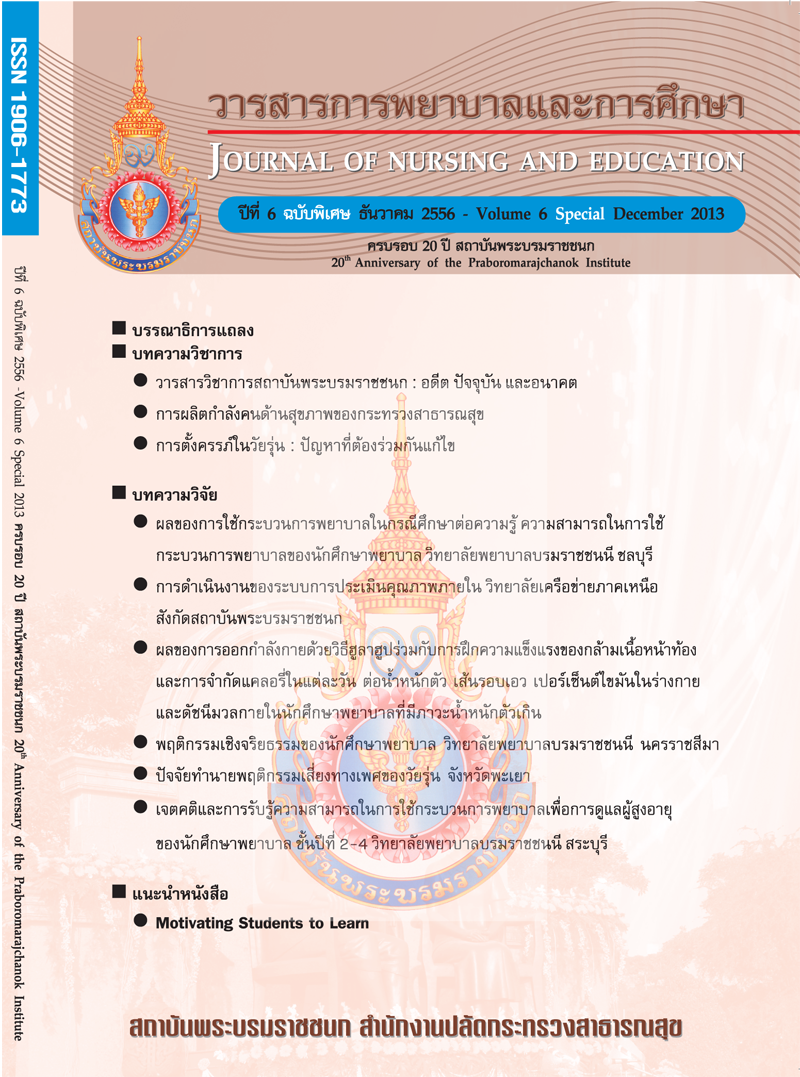ปัจจัยทำนายพฤติกรรมเสี่ยงทางเพศของวัยรุ่น จังหวัดพะเยา
คำสำคัญ:
sexual risk behavior, adolescent, Problem behavior theoryบทคัดย่อ
บทคัดย่อการวิจัยครั้งนี้เป็นการวิจัยเชิงพรรณนา มีวัตถุประสงค์เพื่อศึกษาพฤติกรรมเสี่ยงทางเพศและปัจจัยทำนายพฤติกรรมเสี่ยงทางเพศของวัยรุ่น จังหวัดพะเยา โดยใช้ทฤษฎีพฤติกรรมที่เป็นปัญหาเป็นกรอบแนวคิดการวิจัย กลุ่มตัวอย่างเป็นนักศึกษาชั้นปีที่ 1 กำลังศึกษาอยู่ในสถาบันอุดมศึกษาในจังหวัดพะเยา จำนวน 233 คน สุ่มกลุ่มตัวอย่างโดยการสุ่มแบบง่าย เก็บรวบรวมข้อมูลโดยใช้แบบสอบถามที่ให้กลุ่มตัวอย่างตอบด้วยตนเองประกอบด้วย 1) ข้อมูลทั่วไป 2) ทัศนคติต่อพฤติกรรมเสี่ยงทางเพศ 3) สัมพันธภาพในครอบครัว 4) การรับสื่อกระตุ้นทางเพศ 5) พฤติกรรมเสี่ยงทางเพศของเพื่อน และ 6) พฤติกรรมเสี่ยงทางเพศ วิเคราะห์ข้อมูลโดยใช้สถิติเชิงพรรณนา สัมประสิทธิสหสัมพันธ์เพียร์สัน และการวิเคราะห์ถดถอยพหุแบบขั้นตอน
ผลการศึกษาพบว่า กลุ่มตัวอย่างมีพฤติกรรมดื่มเครื่องดื่มแอลกอฮอล์และเที่ยวสถานเริงรมย์ คิดเป็นร้อยละ 63.9 และ 51.6 9 ตามลำดับ กลุ่มตัวอย่างร้อยละ 33.9 เคยมีเพศสัมพันธ์กับคู่รักและในจำนวนนี้ระบุว่า อายุน้อยที่สุดเมื่อมีเพศสัมพันธ์ครั้งแรกคือ 13 ปี เคยมีประวัติการตั้งครรภ์และยุติการตั้งครรภ์ด้วยการทำแท้ง ร้อยละ 2.5 กลุ่มตัวอย่างให้เหตุผลที่ยอมมีเพศสัมพันธ์กับคู่รักมากที่สุดคือ รักแฟน (ร้อยละ 73.4) รองลงมาคือ ความอยากรู้อยากลอง (ร้อยละ 41.8) และต้องการให้แฟนรัก (ร้อยละ 27.8 ) ปัจจัยที่ทำนายพฤติกรรมเสี่ยงของวัยรุ่น ได้แก่ พฤติกรรมเสี่ยงทางเพศของเพื่อน ทัศนคติต่อพฤติกรรมเสี่ยงทางเพศ และการรับสื่อกระตุ้นทางเพศ ซึ่งสามารถร่วมกันทำนายพฤติกรรมเสี่ยงทางเพศได้ร้อยละ 23.7
การศึกษาครั้งนี้ช่วยให้เข้าใจปัจจัยที่มีผลต่อพฤติกรรมสี่ยงทางเพศของวัยรุ่นและใช้เป็นแนวทางแก้ไขปัญหาโดยการส่งเสริมทักษะชีวิตที่ใช้ป้องกันพฤติกรรมเสี่ยงทางเพศ เช่น ทัศนคติเกี่ยวกับพฤติกรรมทางเพศที่เหมาะสม ทักษะการปฏิเสธ ทักษะการจัดการกับอารมณ์ทางเพศ เป็นต้น และควรสนับสนุนการสร้างแกนนำสุขภาพ นอกจากนี้หน่วยงานภาครัฐควรมีนโยบายควบคุมและพัฒนาสื่อสาธารณะที่เกี่ยวกับเรื่องเพศให้เป็นสื่อที่เหมาะสม
คำสำคัญ : พฤติกรรมเสี่ยงทางเพศ วัยรุ่น ทฤษฎีพฤติกรรมที่เป็นปัญหา
Abstract
A descriptive study was designed to study the sexual risk behavior situation and identify predictors of sexual risk behavior among adolescents derived from Problem Behavior Theory (PBT). The samples of the study consisted of 233 first-year students who were studying in higher education in Phayao Province by using sample random sampling. The data were collected by using self-administered questionnaire including 1) Demographic data; 2) Attitudes towards sexual behavior; 3) Parent-adolescent relationships; 4) Peer sexual risk behavior; 5) Exposure to sexual media; and 6) Sexual risk behavior. Data analyses were descriptive statistics, Pearson's Correlation and Stepwise Multiple Regression.
The findings indicated that 63.9 % had consumed alcohol, 51.69 % went to entertainment places. About 33.9 % had experienced sexual intercourse and among of this group, the age of first sexual intercourse was 13 years, 2.5 % had become pregnant and resulted in abortions. The reasons reported for having sexual intercourse were falling in love (73.4 %), curiosity about sex (41.8%) and needed to be loved (27.8%). The predictors of sexual risk behavior included attitudes towards sexual behavior, peer sexual risk behavior and exposure to sexual media. These factors took account about 23.7% of variance in explaining sexual risk behavior.
This study provides a better understanding of factors influencing sexual risk behavior among adolescents. The finding can be used as guidelines to promote life skills in sexual problem prevention such as proper attitude toward sexual behavior, refusal skills and sexual emotional management skills. Promoting peer leaders should be encouraged. Furthermore, government organizations should place the policy on controlling and developing public media regarding sexuality as suitable media.
Keywords : sexual risk behavior, adolescent, Problem behavior theory






